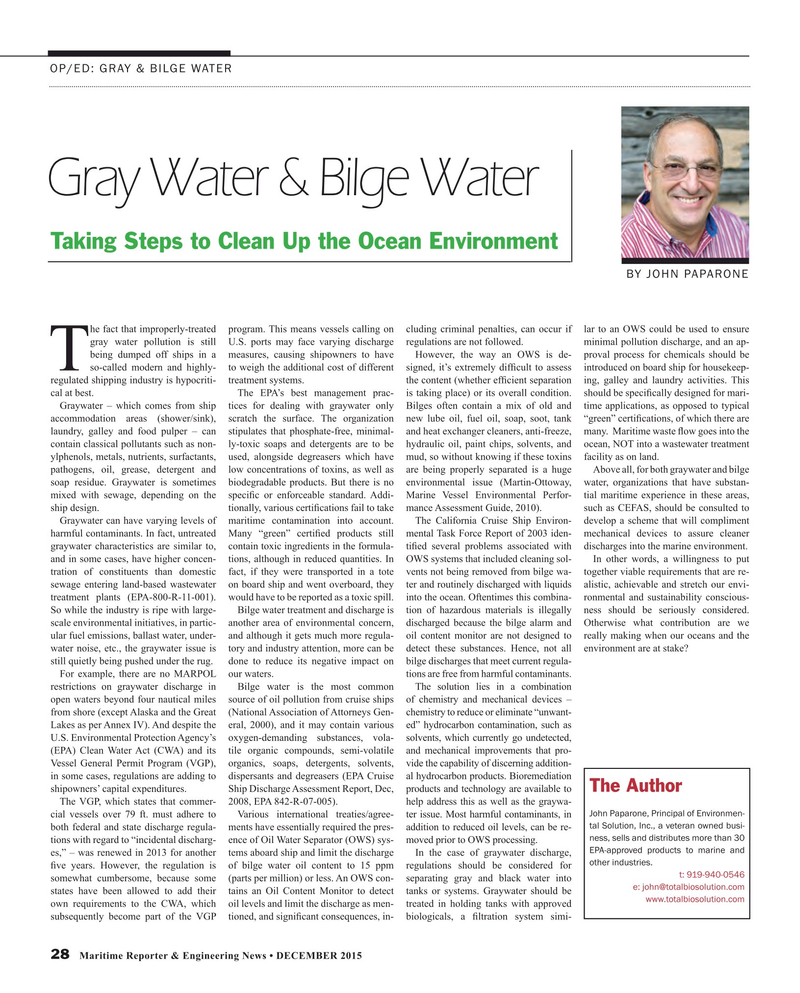
Page 28: of Maritime Reporter Magazine (December 2015)
Great Ships of 2015
Read this page in Pdf, Flash or Html5 edition of December 2015 Maritime Reporter Magazine
OP/ED: GRAY & BILGE WATER
Gray Water & Bilge Water
Taking Steps to Clean Up the Ocean Environment
BY JOHN PAPARONE he fact that improperly-treated program. This means vessels calling on cluding criminal penalties, can occur if lar to an OWS could be used to ensure gray water pollution is still U.S. ports may face varying discharge regulations are not followed. minimal pollution discharge, and an ap- being dumped off ships in a measures, causing shipowners to have However, the way an OWS is de- proval process for chemicals should be
Tso-called modern and highly- to weigh the additional cost of different signed, it’s extremely dif? cult to assess introduced on board ship for housekeep- regulated shipping industry is hypocriti- treatment systems. the content (whether ef? cient separation ing, galley and laundry activities. This cal at best. The EPA’s best management prac- is taking place) or its overall condition. should be speci? cally designed for mari-
Graywater – which comes from ship tices for dealing with graywater only Bilges often contain a mix of old and time applications, as opposed to typical accommodation areas (shower/sink), scratch the surface. The organization new lube oil, fuel oil, soap, soot, tank “green” certi? cations, of which there are laundry, galley and food pulper – can stipulates that phosphate-free, minimal- and heat exchanger cleaners, anti-freeze, many. Maritime waste ? ow goes into the contain classical pollutants such as non- ly-toxic soaps and detergents are to be hydraulic oil, paint chips, solvents, and ocean, NOT into a wastewater treatment ylphenols, metals, nutrients, surfactants, used, alongside degreasers which have mud, so without knowing if these toxins facility as on land.
pathogens, oil, grease, detergent and low concentrations of toxins, as well as are being properly separated is a huge Above all, for both graywater and bilge soap residue. Graywater is sometimes biodegradable products. But there is no environmental issue (Martin-Ottoway, water, organizations that have substan- mixed with sewage, depending on the speci? c or enforceable standard. Addi- Marine Vessel Environmental Perfor- tial maritime experience in these areas, ship design. tionally, various certi? cations fail to take mance Assessment Guide, 2010). such as CEFAS, should be consulted to
Graywater can have varying levels of maritime contamination into account. The California Cruise Ship Environ- develop a scheme that will compliment harmful contaminants. In fact, untreated Many “green” certi? ed products still mental Task Force Report of 2003 iden- mechanical devices to assure cleaner graywater characteristics are similar to, contain toxic ingredients in the formula- ti? ed several problems associated with discharges into the marine environment. and in some cases, have higher concen- tions, although in reduced quantities. In OWS systems that included cleaning sol- In other words, a willingness to put tration of constituents than domestic fact, if they were transported in a tote vents not being removed from bilge wa- together viable requirements that are re- sewage entering land-based wastewater on board ship and went overboard, they ter and routinely discharged with liquids alistic, achievable and stretch our envi- treatment plants (EPA-800-R-11-001). would have to be reported as a toxic spill. into the ocean. Oftentimes this combina- ronmental and sustainability conscious-
So while the industry is ripe with large- Bilge water treatment and discharge is tion of hazardous materials is illegally ness should be seriously considered. scale environmental initiatives, in partic- another area of environmental concern, discharged because the bilge alarm and Otherwise what contribution are we ular fuel emissions, ballast water, under- and although it gets much more regula- oil content monitor are not designed to really making when our oceans and the water noise, etc., the graywater issue is tory and industry attention, more can be detect these substances. Hence, not all environment are at stake?
still quietly being pushed under the rug. done to reduce its negative impact on bilge discharges that meet current regula-
For example, there are no MARPOL our waters. tions are free from harmful contaminants.
restrictions on graywater discharge in Bilge water is the most common The solution lies in a combination open waters beyond four nautical miles source of oil pollution from cruise ships of chemistry and mechanical devices – from shore (except Alaska and the Great (National Association of Attorneys Gen- chemistry to reduce or eliminate “unwant-
Lakes as per Annex IV). And despite the eral, 2000), and it may contain various ed” hydrocarbon contamination, such as
U.S. Environmental Protection Agency’s oxygen-demanding substances, vola- solvents, which currently go undetected, (EPA) Clean Water Act (CWA) and its tile organic compounds, semi-volatile and mechanical improvements that pro-
Vessel General Permit Program (VGP), organics, soaps, detergents, solvents, vide the capability of discerning addition- in some cases, regulations are adding to dispersants and degreasers (EPA Cruise al hydrocarbon products. Bioremediation
The Author shipowners’ capital expenditures. Ship Discharge Assessment Report, Dec, products and technology are available to
The VGP, which states that commer- 2008, EPA 842-R-07-005). help address this as well as the graywa-
John Paparone, Principal of Environmen- cial vessels over 79 ft. must adhere to Various international treaties/agree- ter issue. Most harmful contaminants, in tal Solution, Inc., a veteran owned busi- both federal and state discharge regula- ments have essentially required the pres- addition to reduced oil levels, can be re- ness, sells and distributes more than 30 tions with regard to “incidental discharg- ence of Oil Water Separator (OWS) sys- moved prior to OWS processing.
EPA-approved products to marine and es,” – was renewed in 2013 for another tems aboard ship and limit the discharge In the case of graywater discharge, other industries. ? ve years. However, the regulation is of bilge water oil content to 15 ppm regulations should be considered for t: 919-940-0546 somewhat cumbersome, because some (parts per million) or less. An OWS con- separating gray and black water into e: [email protected] states have been allowed to add their tains an Oil Content Monitor to detect tanks or systems. Graywater should be www.totalbiosolution.com own requirements to the CWA, which oil levels and limit the discharge as men- treated in holding tanks with approved subsequently become part of the VGP tioned, and signi? cant consequences, in- biologicals, a ? ltration system simi- 28 Maritime Reporter & Engineering News • DECEMBER 2015
MR #12 (26-33).indd 28 12/4/2015 4:14:09 PM

 27
27

 29
29
